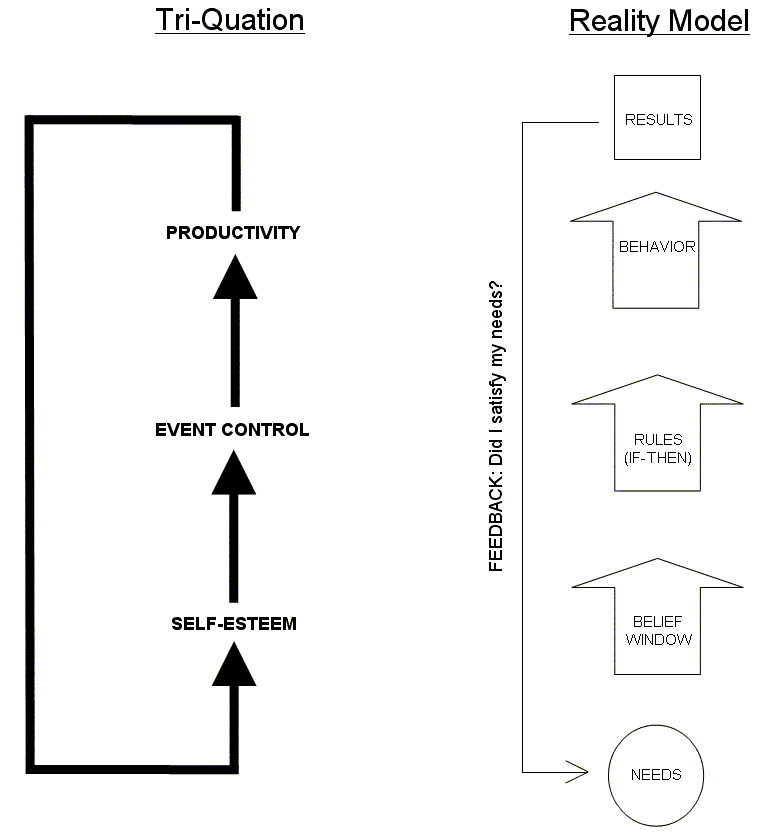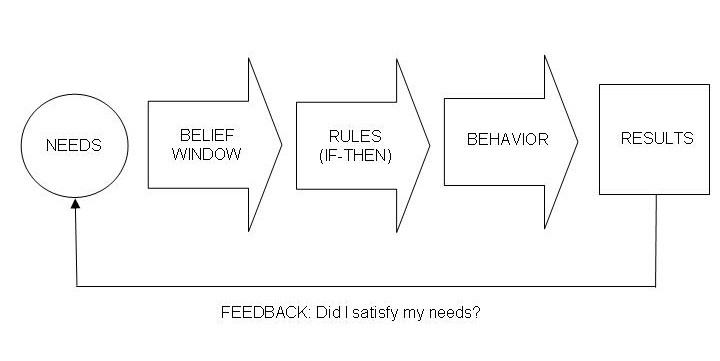|
|
|||
|
|
|

|
|
|
|
|||
|
|
|
|
|
Experiencing Objectivism through the Reality Model  For discussion, the Reality Model normally falls into a horizontal flow format as shown below.  Like all living organisms, humans have a certain set of basic needs they must have met to continue to exist. Several models of human needs have arisen over the years. Franklin Quest chose to adopt the model of 1950s psychiatrist Dr. Murray Banks, who argued that all humans have four basic categories of needs:
Any guiding principle that provides a sense of certainty about meaning and direction in life meets the definition of a belief. Beliefs act as a person's prearranged, organized filters to his perceptions of the world. Humans form beliefs early in their lives because they are necessary for human survival. People make observations and draw conclusions that should serve them later. Consider the belief that "a hot stove should not be touched." This belief protects the believer from injuring himself by preventing him from touching the stove, thus satisfying his need to live without pain. Of course, people often form beliefs that do not serve them at all, and in fact frequently harm themselves and their loved ones. Consider the alcoholic who believes that "one drink won't hurt." This addict's self-deception will probably lead him to experience another bout with alcoholism and probably bring emotional hardship to himself and his family. In fact, Smith defines "addiction" as any behavior that produces short-term pleasure at the expense of long-term pain to the addict or those around the addict. The metaphor used in the Reality Model is that of a "Belief Window", which is basically an invisible "window" hanging in front of a person's face and through which he perceives the world. Each person's window contains written statements of his own beliefs. Outside sensations pass through this window for assignment of meaning, including in many cases a null meaning. Without this belief window, a person would soon go mad from trying to absorb the multitudes of outside sensations bombarding people constantly. Based on a person's general beliefs, he forms If-Then Rules about what his Behavior should be in a given situation and act accordingly. He then observes the Results he produces and the Feedback given to his brain, which must determine whether the belief satisfied the believer's fundamental Needs. If the answer is "Yes," the belief gets reinforced. Otherwise, the belief erodes. The mental anguish of cognitive dissonance results from attempting to implement two conflicting beliefs in the same situation at the same time. This anguish so unsettles the brain that it will almost always discard the more painful of the two beliefs. Smith's book provides great detail about the employment of this model and contains wonderful stories about seminar clients who apply it for prompt behavioral changes. One of the natural laws this model reveals states that results take time to measure. History offers lessons to those willing to learn them. Placing widely practiced principles of the past onto the Belief Window of the Reality Model and then testing them intellectually provide instant lessons and insight into how ideas and philosophy influence history. Likewise, one can test one's Governing Values to learn whether they affirm or deny one's own unique Needs as a human being over time. A future article will examine how to implement beliefs properly in a social context. Discuss this Article (20 messages) |